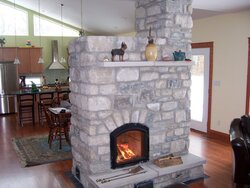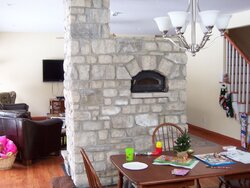Just wanted to give some details and input to anyone who is considering a masonry heater. We've been using ours for a month now to heat a 3000 sq ft home with a full unheated cellar. The temperatures have been in the 30-40's during the day and the 20's at night, so fairly mild. The heater has provided 95% of all of our heat with the furnace kicking on only a few times. We have been burning a 50 lb load of oak/hickory once or twice a day. The wood is from trees that fell over the summer but were just cut and split recently (in other words not really seasoned). I suspect that if the wood was dryer it would produce even more heat. The heat it produces is very mild, it will not heat you out of the room. The house is two story and tightly insulated with spray foam. We built the house around the heater so it was centrally positioned and the chimney runs through the heated envelope of the house. We do not need to use any fans to distribute the heat and our house stays warm even far from the heater. The heater is a Temp-Cast unit and draws great (I first tested the unit in August when it was 80F). The fire view door stays very clear but the bake oven door gets covered in soot easily. We do not have outside air, the black cast iron door below the fireplace is the air intake. Our damper lever is near the floor and is almost an airtight damper.
Originally when we build the house I was planning on getting a wood stove (Woodstock) but my wife wanted a fireplace. We looked at the pre-fab zero clearance from QuadraFire and Napoleon first. They were very nice but required blowers to effectively produce heat and I wanted to be as independent from the grid as possible. The cost of the masonry heater was about 25% more and had other advantages such as real stone, a bake oven, and no moving or electric parts to break. Temp-Cast is the company that I used. They sell the cast refractory blocks and hardware used to make the core of the unit. They have been excellent to deal with and I would highly recommend their product to anyone considering an masonry heater. The unit is assembled from giant 50-120 lb Leggo blocks mortared together. I was able to do this myself with no previous experience. The unit then needs to have a chimney either of steel or masonry attached to the core and the entire unit needs to be surrounded by a veneer of 4-6 brick or stone. I hired professionals for this part. The entire unit weights about 7000 lbs so the foundation needs to be substantial.
Masonry heaters work on the concept of thermal mass. The unit is fired with 50 lbs of wood once or twice a day. The fire is allowed to burn hot and fast then the air intake and damper are closed. If my wood was dry this would take about 1.5 hrs. Since my wood is not seasoned well this takes about 2.5 hrs. The heat from the fire get absorbed by the masonry and slowly released to the house over the next 24 hours. The first time you fire the heater in the season it takes about a day to get it warm and producing heat. Once it's heated up it will stay warm for at least 24 hours (more like 48) and will continue to heat your home. Unlike a wood stove, most of the heat it produces is after the fire goes out. If you go away for a week you will need some sort of backup heat because the masonry heater will take a good 24 hours to warm the house back up, but on the same token, if you leave for 1-2 days your house will still be warm(ish). I feel safe leaving the house with the fire burning but you need to turn off the intake and damper when the fire just goes out or the heater will eventually send most of the heat out of the chimney. This is something that requires a bit of a commitment. In other words, once you light the fire you need to be home to shut the damper and air intake 2 hours later or a lot of the heat will be lost. Since the wood burns hot you will have little to no creosote (Unless you try to burn wet wood, give up, close the damper and air intake only to find it smoldered to ash the next day as I did this summer when testing the unit).
The bake oven is heated by the fire below. It is a "black oven" which means the fire from the firebox passes through the oven and some black ash gets in the oven when the fire is burning. You cannot use the oven when the fire is burning. Once the fire is out you simply brush out the fly ash (if any) and put in your food. The temperature is only adjustable by the timing of the fire. Right after the fire the oven is 500-550 and it will stay at this temperature for about 1-2 hours then it will slowly go down. Some masonry heater companies have a white oven (Heat-Kit) which allows you to cook even during the fire because the fire and smoke do not pass through the oven. I have only used the oven a couple of times but it has worked very well.
Masonry heaters are reported to use 25-50% less wood than a stove to produce the same amount of heat. I don't have enough experience to comment on this. One benefit I have noticed over a wood stove is that it does not dry the air, there is no burnt dust smell, nor is there the smell of smoke in the house. The unit gets warm but will not burn you if you touch it like a wood stove (unless you touch the door/window). Since the wood is burnt without a damper there is very little pollution and are considered one of the cleanest wood burning appliances.
The biggest downside of a masonry heater is the cost. I'll discuss this on another post. I hope this helps.
Originally when we build the house I was planning on getting a wood stove (Woodstock) but my wife wanted a fireplace. We looked at the pre-fab zero clearance from QuadraFire and Napoleon first. They were very nice but required blowers to effectively produce heat and I wanted to be as independent from the grid as possible. The cost of the masonry heater was about 25% more and had other advantages such as real stone, a bake oven, and no moving or electric parts to break. Temp-Cast is the company that I used. They sell the cast refractory blocks and hardware used to make the core of the unit. They have been excellent to deal with and I would highly recommend their product to anyone considering an masonry heater. The unit is assembled from giant 50-120 lb Leggo blocks mortared together. I was able to do this myself with no previous experience. The unit then needs to have a chimney either of steel or masonry attached to the core and the entire unit needs to be surrounded by a veneer of 4-6 brick or stone. I hired professionals for this part. The entire unit weights about 7000 lbs so the foundation needs to be substantial.
Masonry heaters work on the concept of thermal mass. The unit is fired with 50 lbs of wood once or twice a day. The fire is allowed to burn hot and fast then the air intake and damper are closed. If my wood was dry this would take about 1.5 hrs. Since my wood is not seasoned well this takes about 2.5 hrs. The heat from the fire get absorbed by the masonry and slowly released to the house over the next 24 hours. The first time you fire the heater in the season it takes about a day to get it warm and producing heat. Once it's heated up it will stay warm for at least 24 hours (more like 48) and will continue to heat your home. Unlike a wood stove, most of the heat it produces is after the fire goes out. If you go away for a week you will need some sort of backup heat because the masonry heater will take a good 24 hours to warm the house back up, but on the same token, if you leave for 1-2 days your house will still be warm(ish). I feel safe leaving the house with the fire burning but you need to turn off the intake and damper when the fire just goes out or the heater will eventually send most of the heat out of the chimney. This is something that requires a bit of a commitment. In other words, once you light the fire you need to be home to shut the damper and air intake 2 hours later or a lot of the heat will be lost. Since the wood burns hot you will have little to no creosote (Unless you try to burn wet wood, give up, close the damper and air intake only to find it smoldered to ash the next day as I did this summer when testing the unit).
The bake oven is heated by the fire below. It is a "black oven" which means the fire from the firebox passes through the oven and some black ash gets in the oven when the fire is burning. You cannot use the oven when the fire is burning. Once the fire is out you simply brush out the fly ash (if any) and put in your food. The temperature is only adjustable by the timing of the fire. Right after the fire the oven is 500-550 and it will stay at this temperature for about 1-2 hours then it will slowly go down. Some masonry heater companies have a white oven (Heat-Kit) which allows you to cook even during the fire because the fire and smoke do not pass through the oven. I have only used the oven a couple of times but it has worked very well.
Masonry heaters are reported to use 25-50% less wood than a stove to produce the same amount of heat. I don't have enough experience to comment on this. One benefit I have noticed over a wood stove is that it does not dry the air, there is no burnt dust smell, nor is there the smell of smoke in the house. The unit gets warm but will not burn you if you touch it like a wood stove (unless you touch the door/window). Since the wood is burnt without a damper there is very little pollution and are considered one of the cleanest wood burning appliances.
The biggest downside of a masonry heater is the cost. I'll discuss this on another post. I hope this helps.



